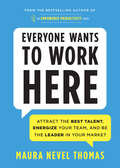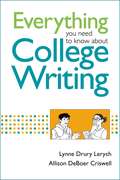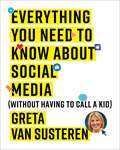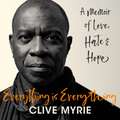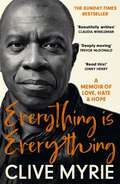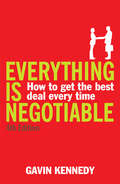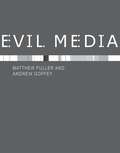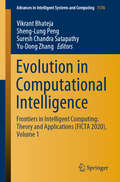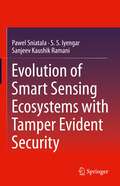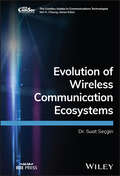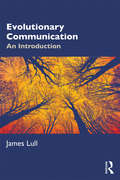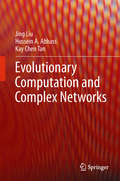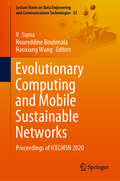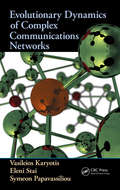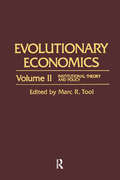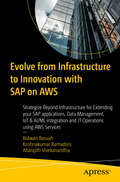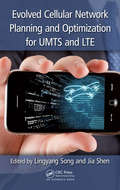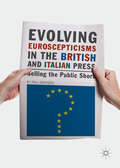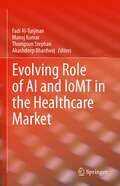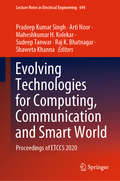- Table View
- List View
Everyday Voice Care: The Lifestyle Guide For Singers And Talkers
by Joanna CazdenThe human voice expresses more than words, more than music. Vocal expression links the listener directly to another person's inner feelings, body, and soul. Keeping the voice healthy used to be as mysterious as the power of voice itself. Modern science has revealed much about the vocal mechanism and its health requirements, but simple information for the average voice user has remained hard to find and harder to trust. In Everyday Voice Care: The Lifestyle Guide for Singers and Talkers , respected voice therapist Joanna Cazden brings together a wealth of practical tips and advice to help keep your own expressive voice in top working order. Drawing from her experience as a singer, theater artist, and a licensed speech pathologist who has treated more than 1,000 voice patients, Cazden integrates up-to-date medical information with common-sense suggestions and sympathy for the demands of contemporary life. Chapters on food and drink, cold remedies, loud parties, travel, fitness routines, and when to see a doctor are complemented by notes on alternative health care and the spiritual dimension of vocal rest. This invaluable resource for voice and speech professionals, students, and teachers will answer even the age-old question of whether to put lemon or honey in your tea.
Everyone Wants to Work Here: Attract the Best Talent, Energize Your Team, and Be the Leader in Your Market (Empowered Productivity)
by Maura ThomasBe the leader your team wants to followYou want to be the kind of leader that leaves a legacy of positive impact. You want to lead an exceptional team so you can power your organization's success and unleash the hidden potential in every team member – including yourself! So how do you realize these goals?In this expansive guide, expert Maura Thomas explores how to combat insidious problems that are costing your organization millions. You can change the status quo with her step-by-step guidance to energize your team, and provide greater focus, transparency, and accountability in the organization. Leaders and aspiring leaders like you will discover how to not only extinguish—but prevent—the dozens of "fires" that pop up all day. You can transform a stressful culture into an empowering one, or a great culture into one where top talent is lining up to be a part of your team. Imagine having consistently productive and satisfying work days, and contributing even more to the organization—but in a way that's inspiring and motivating instead of overwhelming and depleting.The techniques in this book will not only help you, your team and your organization, they'll boost your ability to contribute in a positive way to families, your community, and the world.
Everything You Need To Know About College Writing
by Allison Deboer Criswell Lynne Drury LerychIn their teaching, community college instructors Lynne Lerych and Allison DeBoer Criswell have discovered that a unique combination of humor and coaching helps overwhelmed students successfully master the conventions of academic writing. Now they have translated their experience into an engaging text to reach even the most wary students. Everything You Need to Know About College Writing is anchored by a sequenced, hands-on-approach to teaching rhetorical skills that help students face their fears of writing. This practical method starts by modeling each concept in action, then asks students to discuss and explore the concept together, and ends with an opportunity to practice. The authors' compelling tone--and presence as illustrated characters throughout the book-- keep students returning to the text for more on-the-page instruction. Filled with relevant student examples at every stage of the writing process, illustrated student writers whose progress and thought process the text follows, and engaging activities at when they're needed most, the text offers a unique way of untangling the toughest writing tasks while helping students to learn from mistakes. Plenty of grammar and mechanics coverage, plus tips throughout, help even the most reluctant writers stay on track. A mini-reader, a brief section on writing across the curriculum, and another on citation conventions appear at the end of the book to round out its robust support for all elements of a writing course in a small package.
Everything You Need to Know about Social Media: Without Having to Call A Kid
by Greta Van SusterenA simple, step-by-step guide to the major social media platforms—Facebook, Twitter, LinkedIn, Instagram, Snapchat, and more—by former news anchor and media maven Greta Van Susteren.
Everything is Everything: A Memoir of Love, Hate & Hope
by Clive Myrie'I've realised that my skin colour, and the sensibilities acquired living in a white dominated world, have given me an interesting perspective on a myriad of topics and issues... So Everything is Everything is about the intersection of the personal and the professional and what I've learned. There is tough stuff, but also hope.'As a Bolton teenager with a paper round Clive Myrie read all the newspapers he delivered from cover to cover, and dreamed of becoming a journalist. Thirty years on, he's reported from more than ninety countries for the BBC. In this deeply personal memoir, he reflects on how being black has affected his perspective on the myriad issues he's encountered in reporting some of the biggest stories of our time. Clive's empathy for the individual caught up in large historical events is widely recognised. He tells how his family history has influenced his view of the world, introducing us to his Windrush generation parents, a great grandfather who helped build the Panama Canal, and a great uncle who fought in the First World War and later became a prominent police detective in Jamaica. In Everything is Everything, he shows how his own life experience might afford a better idea of what it means to be an outsider. He tells us of his pride in his roots, but his determination not to be defined by his background in dealing with the challenges of race and class, to succeed at the highest level. Moving, engaging, revealing, Everything is Everything is a story of both love and hate - but also hope.(P) 2023 Hodder & Stoughton Limited
Everything is Everything: The Top 10 Bestseller
by Clive Myrie'Infinitely more readable than the average journalism memoir, and decidedly more important.' - Sathnam Sanghera, The Times'So engaging. You feel as if he is talking to you, sharing ideas and thoughts, as if you were a friend.' - Yasmin Ahlibai-BrownAs a Bolton teenager with a paper round, Clive Myrie read all the newspapers he delivered from cover to cover and dreamed of becoming a journalist. In this deeply personal memoir, he tells how his family history has influenced his view of the world, introducing us to his Windrush generation parents, a great grandfather who helped build the Panama Canal, and a great uncle who fought in the First World War, later to become a prominent police detective in Jamaica.He reflects on how being black has affected his perspective on issues he's encountered in thirty years reporting some of the biggest stories of our time (most recently from Ukraine), showing us how those experiences gave him a better idea of what it means to be an outsider. He tells of his pride in his roots, but his determination not to be defined by his background in dealing with the challenges of race and class to succeed at the highest level. Moving, engaging, revealing, Everything is Everything is a story of love and hate - but also hope.
Everything is Everything: The Top 10 Bestseller
by Clive Myrie'Infinitely more readable than the average journalism memoir, and decidedly more important.' - Sathnam Sanghera, The Times'So engaging. You feel as if he is talking to you, sharing ideas and thoughts, as if you were a friend.' - Yasmin Ahlibai-BrownAs a Bolton teenager with a paper round, Clive Myrie read all the newspapers he delivered from cover to cover and dreamed of becoming a journalist. In this deeply personal memoir, he tells how his family history has influenced his view of the world, introducing us to his Windrush generation parents, a great grandfather who helped build the Panama Canal, and a great uncle who fought in the First World War, later to become a prominent police detective in Jamaica.He reflects on how being black has affected his perspective on issues he's encountered in thirty years reporting some of the biggest stories of our time (most recently from Ukraine), showing us how those experiences gave him a better idea of what it means to be an outsider. He tells of his pride in his roots, but his determination not to be defined by his background in dealing with the challenges of race and class to succeed at the highest level. Moving, engaging, revealing, Everything is Everything is a story of love and hate - but also hope.
Everything is Fine: The funny, feel-good and uplifting page-turner you won't be able to put down!
by Gillian Harvey'Just the escapism we need right now' EVENING STANDARD'Hilarious and relatable' WOMAN'A perfect weekend read' GRAZIAJessica Bradley has it all: the perfect boyfriend; influential healthy-eating blog; successful PR company and wonderful daughter, Anna. Or at least that is what her thousands of followers believe.The truth is, her boyfriend just broke up with her in four words on a post-it; her zest for healthy-eating has all but disappeared; her PR success is all reliant on her now not-so-honest online-life and she just got caught eating her daughter's Coco-Pops. So as they say: fake it 'til you make it. A few little white lies and phoney smiling selfies and Jess can keep up appearances. But when her real-life starts to spiral out of control how can Jess tell the truth from the lies? And will she be able to seize real happiness when it is right in front of her?Hilarious, heart-warming and oh-so relatable, Everything Is Fine is perfect for fans of Louise Pentland, Anna Bell and Lindsey Kelk.'Funny and uplifting' BELLA'Hilarious, heartwarming and relatable' NEW! Magazine'Made me laugh out loud so many times!' Lucy Vine'Feel-good, funny, and very relatable' Anna Bell'Funny and honest' Elizabeth Buchan
Everything is Fine: The funny, feel-good and uplifting page-turner you won't be able to put down!
by Gillian Harvey'Just the escapism we need right now' EVENING STANDARD'Hilarious and relatable' WOMAN'A perfect weekend read' GRAZIAJessica Bradley has it all: the perfect boyfriend; influential healthy-eating blog; successful PR company and wonderful daughter, Anna. Or at least that is what her thousands of followers believe.The truth is, her boyfriend just broke up with her in four words on a post-it; her zest for healthy-eating has all but disappeared; her PR success is all reliant on her now not-so-honest online-life and she just got caught eating her daughter's Coco-Pops. So as they say: fake it 'til you make it. A few little white lies and phoney smiling selfies and Jess can keep up appearances. But when her real-life starts to spiral out of control how can Jess tell the truth from the lies? And will she be able to seize real happiness when it is right in front of her?Hilarious, heart-warming and oh-so relatable, Everything Is Fine is perfect for fans of Louise Pentland, Anna Bell and Lindsey Kelk.'Funny and uplifting' BELLA'Hilarious, heartwarming and relatable' NEW! Magazine'Made me laugh out loud so many times!' Lucy Vine'Feel-good, funny, and very relatable' Anna Bell'Funny and honest' Elizabeth Buchan
Everything is Negotiable: 4th Edition
by Gavin KennedyWhether you need to ask for a raise at work, request a better hotel room while you're on holiday, or even debate with your stubborn teenager at home, you can learn effective and powerful negotiation skills to help you get the best deal every time.In this fully revised and updated fourth edition of the worldwide success Everything is Negotiable, expert negotiator Gavin Kennedy walks you through all the techniques and tricks you need to get the best deal in any situation. With chapters on such subjects as making your offer count, dealing with intimidation and getting it in writing, as well as self-assessment tests to help chart your progress, Everything is Negotiable is a one-stop shop for anyone who wants to improve their negotiation skills. Superbly practical and insightful, this essential guide will make sure you come out top in any negotiation.
Evidence-Based Treatment of Stuttering: Empirical Bases and Clinical Applications
by Anne K. BotheThis book is the result of a "State-of-the-Art-Conference" held at the University of Georgia dedicated to the evidence-based treatment of stuttering. An international group of prominent fluency researchers and clinicians were invited to present and discuss current data and issues related to the treatment of stuttering. The topic was defined to include evidence about stuttering, evidence about stuttering treatment, and discussions of how that evidence should guide the continuing research and practice. The explicit link between empirical evidence and suggestions for clinical practice is the goal of the book. The book begins by addressing the notion of "evidence-based practice" and considers its implications for stuttering treatment. Part II presents the intersection of the nature of stuttering; the theories of stuttering; and the implications of nature, theory, and other knowledge for stuttering treatment decisions. Part III provides two of the many measurement issues facing stuttering treatment followed by Part IV, which is devoted to the quality of treatment research evidence, for specific treatments and in terms of some more general methodological and professional issues. The final part summarizes the clinical recommendations made throughout the book and discusses evidence-based, outcomes-focused clinical decisions for stuttering. These chapters are intended to provide "state-of-the-art" information to researchers, clinicians, and students who are interested in developing, identifying, or using the best possible evidence-based treatments for stuttering.
Evil Media
by Matthew Fuller Andrew GoffeyEvil Media develops a philosophy of media power that extends the concept of media beyond its tried and trusted use in the games of meaning, symbolism, and truth. It addresses the gray zones in which media exist as corporate work systems, algorithms and data structures, twenty-first century self-improvement manuals, and pharmaceutical techniques. Evil Media invites the reader to explore and understand the abstract infrastructure of the present day. From search engines to flirting strategies, from the value of institutional stupidity to the malicious minutiae of databases, this book shows how the devil is in the details. The title takes the imperative "Don't be evil" and asks, what would be done any differently in contemporary computational and networked media were that maxim reversed. Media here are about much more and much less than symbols, stories, information, or communication: media do things. They incite and provoke, twist and bend, leak and manage. In a series of provocative stratagems designed to be used, Evil Media sets its reader an ethical challenge: either remain a transparent intermediary in the networks and chains of communicative power or become oneself an active, transformative medium.
Evolution in Computational Intelligence: Frontiers in Intelligent Computing: Theory and Applications (FICTA 2020), Volume 1 (Advances in Intelligent Systems and Computing #1176)
by Suresh Chandra Satapathy Vikrant Bhateja Sheng-Lung Peng Yu-Dong ZhangThis book presents the proceedings of 8th International Conference on Frontiers of Intelligent Computing: Theory and Applications (FICTA 2020), which aims to bring together researchers, scientists, engineers and practitioners to share new ideas and experiences in the domain of intelligent computing theories with prospective applications to various engineering disciplines. The book is divided into two volumes: Evolution in Computational Intelligence (Volume 1) and Intelligent Data Engineering and Analytics (Volume 2).Covering a broad range of topics in computational intelligence, the book features papers on theoretical as well as practical aspects of areas such as ANN and genetic algorithms, computer interaction, intelligent control optimization, evolutionary computing, intelligent e-learning systems, machine learning, mobile computing, and multi-agent systems. As such, it is a valuable reference resource for postgraduate students in various engineering disciplines.
Evolution of Smart Sensing Ecosystems with Tamper Evident Security
by Pawel Sniatala S.S. Iyengar Sanjeev Kaushik RamaniThis book presents an overview on security and privacy issues in dynamic sensor networks and Internet of Things (IoT) networks and provides a novel tamper evident technique to counter and defend against these security related issues. The mission of this book is to explain the evolution of techniques and strategies in securing information transfer and storage thus facilitating a digital transition towards the modern tamper evident systems. The goal is also to aid business organizations that are dependent on the analysis of the large volumes of generated data in securing and addressing the associated growing threat of attackers relentlessly waging attacks and the challenges in protecting the confidentiality, integrity and provenance of data. The book also provides a comprehensive insight into the secure communication techniques and tools that have evolved and the impact they have had in supporting and flourishing the business through the cyber era. This book also includes chapters that discuss the most primitive encryption schemes to the most recent use of homomorphism in ensuring the privacy of the data thus leveraging greater use of new technologies like cloud computing and others.
Evolution of Wireless Communication Ecosystems (The ComSoc Guides to Communications Technologies)
by Suat SecginEvolution of Wireless Communication Ecosystems Understand a world transformed by wireless communication with this groundbreaking guide Since the advent of the internet, few technologies have proven more transformative than wireless communication. Never have we lived in a more comprehensively connected world, with the cloud and the coming sixth generation (6G) of wireless technology creating a vast and interconnected communications infrastructure. Global citizens of this newly interconnected reality are grappling like never before with its many challenges. Evolution of Wireless Communication Ecosystems provides readers with a history of wireless communication and a thorough overview of emerging frontiers. It traces wireless communication from the first generation through to the current fifth before surveying the current state of wireless technology and the ongoing research into 6G. The result is a book that understands wireless communication for the first time as an ecosystem, endlessly interconnected, growing, and boundlessly complex, but made intelligible by this highly readable introduction. Readers will also find: Detailed explanations of the journey starting from 1G to 6G Descriptions the infrastructure of 4G, 5G, and 6G systems, this all-connected communication ecosystem, the sub-components of this ecosystem, and the relationship among them Depictions of events seen in the capillaries of the communication echo system that show switching techniques, modulation, and multiplexing techniques Coverage of access techniques, protocols, the methods used in M2M and IoT connections at the endpoints, and security issues that show how they are an integral part of wireless communication infrastructure Evolution of Wireless Communication Ecosystems from 1G to 6G is an essential reference for wireless and telecommunications professionals, as well as researchers interested in 6G or other emerging wireless technologies.
Evolutionary Communication: An Introduction
by James LullEvolutionary Communication presents the first comprehensive evolutionary approach to the study of human communication. Presuming no specialized knowledge of evolutionary theory, this reader-friendly textbook explains why and how communication became the determining factor in human development. Drawing from the latest scientific research, Evolutionary Communication represents a truly groundbreaking contribution to Communication Studies as a field of study. Opening up an inspiring new approach for teaching communication, the book can be used as a core volume or supplemental text for courses ranging from Introduction to Communication and Communication Theory to special topics and graduate seminars.
Evolutionary Computation and Complex Networks
by Hussein A. Abbass Jing Liu Kay Chen TanThis book introduces the linkage between evolutionary computation and complex networks and the advantages of cross-fertilising ideas from both fields. Instead of introducing each field individually, the authors focus on the research that sits at the interface of both fields. The book is structured to address two questions: (1) how complex networks are used to analyze and improve the performance of evolutionary computation methods? (2) how evolutionary computation methods are used to solve problems in complex networks? The authors interweave complex networks and evolutionary computing, using evolutionary computation to discover community structure, while also using network analysis techniques to analyze the performance of evolutionary algorithms. The book is suitable for both beginners and senior researchers in the fields of evolutionary computation and complex networks.
Evolutionary Computing and Mobile Sustainable Networks: Proceedings of ICECMSN 2020 (Lecture Notes on Data Engineering and Communications Technologies #53)
by Haoxiang Wang V. Suma Noureddine BouhmalaThis book features selected research papers presented at the International Conference on Evolutionary Computing and Mobile Sustainable Networks (ICECMSN 2020), held at the Sir M. Visvesvaraya Institute of Technology on 20–21 February 2020. Discussing advances in evolutionary computing technologies, including swarm intelligence algorithms and other evolutionary algorithm paradigms which are emerging as widely accepted descriptors for mobile sustainable networks virtualization, optimization and automation, this book is a valuable resource for researchers in the field of evolutionary computing and mobile sustainable networks.
Evolutionary Dynamics of Complex Communications Networks
by Symeon Papavassiliou Vasileios Karyotis Eleni StaiUntil recently, most network design techniques employed a bottom-up approach with lower protocol layer mechanisms affecting the development of higher ones. This approach, however, has not yielded fascinating results in the case of wireless distributed networks. Addressing the emerging aspects of modern network analysis and design, Evolutionary Dyna
Evolutionary Economics
by Marc R. ToolThis two-volume work is intended to map the theoretical heartland of the institutionalist perspective on political economy. Volume I, "Foundations of Institutional Thought", identifies the origins of institutional economics and explores the primary analytical tools in its development. The papers included in Volume II, "Institutional Theory and Policy", consider basic economic processes, institutions for stabilizing and planning economic activities, the role of power and accountability, and emerging global interdependence. Marc R. Tool is the editor of "Journal of Economic Issues".
Evolve from Infrastructure to Innovation with SAP on AWS: Strategize Beyond Infrastructure for Extending your SAP applications, Data Management, IoT & AI/ML integration and IT Operations using AWS Services
by Bidwan Baruah Abarajith Vivekanandha Krishnakumar RamadossThe world of SAP is undergoing a major transformation, with many customers either planning or actively modernizing their SAP landscapes as part of the S/4HANA digital transformation. Given the extensive SAP transformation efforts adopted by nearly all SAP customers in recent years and the profound impact these digital changes have had on their business models and IT organizations, the authors decided to write this book. As customers embark on their SAP on AWS journey, they face three main challenges: deciding on the overall strategy, selecting the right business use cases and implementing them effectively. This book aims to address these challenges by guiding readers through the process of identifying and executing the appropriate use cases. It will highlight how customers can harness AWS services beyond merely hosting their SAP systems on AWS, demonstrating the potential of these services to drive innovation. This book covers the entire journey, from defining strategy and identifying business use cases to their implementation, providing practical tips, strategies, and insights. It serves as an essential guide for customers planning to migrate or those who have already migrated their SAP workloads to AWS, helping them explore beyond just the infrastructure aspects of their journey. You Will : Discover how to go beyond just hosting SAP systems on AWS, using the full range of AWS services to innovate and extend your SAP applications. Learn how to identify the right business use cases and implement them effectively, with practical examples and real-world scenarios. Develop the mindset and skills needed to architect modern, cloud-native, event-driven architectures, balancing trade-offs between simplicity, efficiency, and cost. This book is for: Business leaders, IT professionals, and SAP specialists who are looking to modernize their SAP landscapes by leveraging AWS services
Evolved Cellular Network Planning and Optimization for UMTS and LTE
by Lingyang Song Jia ShenMost books on network planning and optimization provide limited coverage of either GSM or WCDMA techniques. Few scrape the surface of HSPA, and even fewer deal with TD-SCDMA. Filling this void, Evolved Cellular Network Planning and Optimization for UMTS and LTE presents an accessible introduction to all stages of planning and optimizing UMTS, HSPA,
Evolving Euroscepticisms in the British and Italian Press
by Paul RowinskiThis book argues that the discursive construction of the EU in national newspapers is pivotal in creating an environment of Euroscepticism. The volume challenges the persuasive, manipulative and prejudicial language that is sometimes peddled in the influential UK Murdoch and Italian Berlusconi press, using the main focus points of the key Eurosceptic triggers of the € the subsequent national economic crises; and immigration, investigated through major events covered over two decades, including the UK's recent Brexit vote and Italy's constitutional crisis. Rowinski looks at the latest chapter of Euroscepticism: the increasingly key protagonists of the UK Independence Party and Italy's Five Star Movement, who want to take Britain out of the EU and Italy out of the euro. This book offers a rigorous academic analysis presented in an accessible style to experts and laypersons alike, exploring concrete articulations of Euroscepticism in the press.
Evolving Role of AI and IoMT in the Healthcare Market
by Manoj Kumar Fadi Al-Turjman Akashdeep Bhardwaj Thompson StephanThis book is a proficient guide to understanding artificial intelligence (IoT) and the Internet of Medical Things (IoMT) in healthcare. The book provides a comprehensive study on the applications of AI and IoT in various medical domains. The book shows how the implementation of innovative solutions in healthcare is beneficial, and IoT, together with AI, are strong drivers of the digital transformation regardless of what field the technologies are applied in. Therefore, this book provides a high level of understanding with the emerging technologies on the Internet of Things, wearable devices, and AI in IoMT, which offers the potential to acquire and process a tremendous amount of data from the physical world.
Evolving Technologies for Computing, Communication and Smart World: Proceedings of ETCCS 2020 (Lecture Notes in Electrical Engineering #694)
by Pradeep Kumar Singh Maheshkumar H. Kolekar Sudeep Tanwar Arti Noor Raj K. Bhatnagar Shaweta KhannaThis book presents best selected papers presented at the International Conference on Evolving Technologies for Computing, Communication and Smart World (ETCCS 2020) held on 31 January–1 February 2020 at C-DAC, Noida, India. It is co-organized by Southern Federal University, Russia; University of Jan Wyżykowski (UJW), Polkowice, Poland; and CSI, India. C-DAC, Noida received funding from MietY during the event. The technical services are supported through EasyChair, Turnitin, MailChimp and IAC Education. The book includes current research works in the areas of network and computing technologies, wireless networks and Internet of things (IoT), futuristic computing technologies, communication technologies, security and privacy.

